RetroLisa
------------ | 1910s At Home | |
|
___________________________________________________________________________________________________________
|
|
|
RetroLisa
| __________________________________________________________ | __ | ______________________________________ | _______ | Upper Class
The homes of the wealthy had every modern convenience. This was in sharp contrast to most homes of the period, which often lacked the most basic of comforts.
For rich families, the gilded age was marked by a grand display of conspicuous wealth. In the 1910s, this era was coming to an end. The vulgar excesses of the rich were no longer considered appropriate, and the new income tax of 1914 was keeping large incomes under control.
in the kitchen
Large, modern kitchens contained the latest electric appliances: toasters, waffle irons, refrigerators, and ranges. They also featured hot and cold running water and enough cooking and storage space to prepare dinner for up to 100 guests.
bed & bath
Electric toasters were valued quite highly, which prompted wealthy families to install one in every bedroom and guest room. Bathrooms were modern and luxurious, with flush toilets, built-in tubs, sitz baths, foot baths, pedestal sinks, and therapeutic ribcage shower baths.

entertaining
The mansion had a large hall with space for dancers and an orchestra. The dining room could seat multitudes of guests. The music room had a grand piano, a phonograph, and possibly a parlor organ.
on the grounds
A garage and a small fleet of automobiles replaced the stable, coach, and horses. The coachman's job was now performed by the chauffeur, who was worth his weight in gold if he was also a mechanic. At this point, if a wealthy family owned horses, they were used primarily for pleasure riding. The gardens and walkways were designed by professional landscape architects and were impeccably maintained.
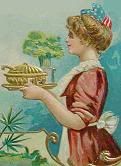
servants
The lady of the house never set foot in the kitchen, never washed a dish, never did a load of laundry, never drew her own bath, never did her own hair, and never drove an automobile. She had servants to do these things.
The rooms were connected to each other by the inter-phone system. In the old days, the lady of the house called the servants by ringing a bell. Now she could summon them by telephone.
the servant problem
Prior to the 1910s, all upper class households had a full staff of servants: maids, butlers, stablehands, gardener, cook, yacht captain, coachman, and nanny. Finding good help was easy, because there was always a permanent servant class to choose from.
In the 1900s and 1910s, things began to change. Servants were getting harder to find. During the 1910s, the number of domestic servants declined by more than half.
In the past, the servant class consisted of immigrants, African-Americans, and single women. After the turn of the century, these groups had new job opportunities available to them, and many preferred to work in factories. Thanks to World War I, immigration from Europe was slowing down, and this reduced the number of people willing to work as servants. Those who remained in domestic service demanded higher salaries.
| |
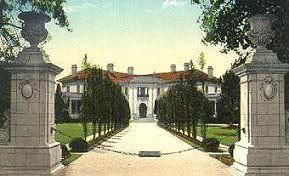
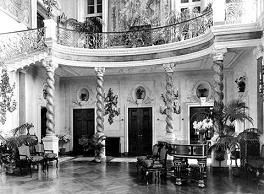
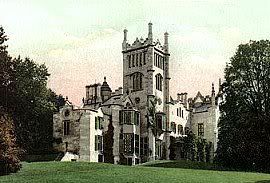
Lyndehurst
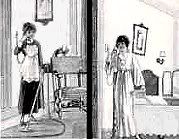
Inter-phone
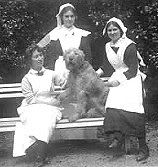
|
________________________________________________________________
|
|
|
RetroLisa
| _________________________________________________________ | __ | _______________________________________ | _______ | Middle Class
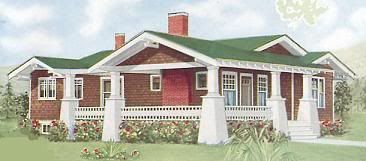
In Victorian times, the one word that best described home decor was MORE. More knick-knacks, more scrollwork, more contrasting colors, and more curtains and tassels. By the 1910s, homeowners desired a simpler look. Suburban middle class homes were less ornate and less cluttered than the Victorian homes of 20 years earlier. Popular home styles included bungalows, prairie style homes, and foursquares with stucco surfaces.
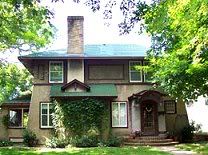
open floor plans
On the first floor, prairie style homes and bungalows usually had an open floor plan, with internal spaces that flowed into each other. Instead of being separated by walls and doors, a parlor and dining room might be separated by nothing more than a large archway or some pillars.
in the parlor
The function of the parlor was changing. In the old days, this musty, seldom-used room was reserved for visitors and special occasions and was basically just for show. In the 1910s, people started calling it the living room, and it was used for all sorts of family gatherings and activities. Here is where you would find the desk telephone, bookshelves, family heirlooms, and comfortable furniture that was meant to be used. Recreational items were also kept here, including the piano, victrola, magic lantern machine, cabinet photographs, stereo viewer, and stereo cards.
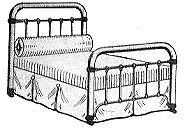
in the bedroom
Bedrooms were also becoming less ornate in the 1910s. The heavy, frilly Victorian look was being replaced by light colors, light fabrics, and a minimum of decoration. This change was the result of new attitudes about health and cleanliness. Wallpaper and heavy bedcurtains were developing a reputation for being unsanitary.
On the walls, white paint and pretty wallpaper borders were replacing the old flowered wallpaper. Chromolithographed prints replaced big, heavy oil paintings.
The addition of central heating in many homes made the bedroom fireplace obsolete. Indoor plumbing reduced the number of bedrooms containing a washstand with bowl and pitcher.
Bedrooms were starting to include built-in closets instead of large wooden wardrobes. Improved window screens kept more insects out, which made sleeping in the summer a more pleasant experience. Large wooden beds were still popular, but so were lightweight steel beds and fold-out sofa beds. The attractive simplicity of mission-style furniture was quickly becoming a favorite look.
adding a driveway & garage
Many families purchased their first motor car during the 1910s. Before this, there was no need for a garage. What passed for a driveway was nothing more than a patch of ground in the front yard where the grass was worn away.
After buying a car, homeowners added gravel or concrete driveways. Building a detached garage eliminated the need to rent space in a commercial garage, which many people did during the winter.
middle class servants
Prior to the 1910s, even middle class households usually had a live-in maid, and perhaps a few other servants hired on a part-time basis. The shortage of domestic servants that plagued the upper classes also affected the middle classes.
By the late 1910s, most middle class households found that they couldn't afford to hire any domestic help at all. Those who did usually hired a part-time housekeeper who lived outside the home.
A middle class household with a live-in maid became the exception, rather than the rule. New brides had grown up assuming that they would direct a full staff of servants when they got married. At the very least, they would have a maid to help out. Suddenly they found themselves doing the housework themselves.
| |
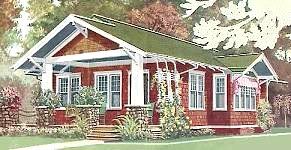
Bungalow, 1918
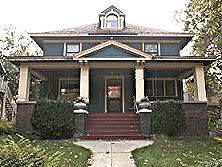
Foursquare
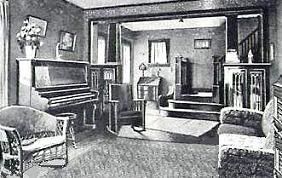
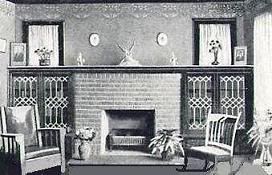
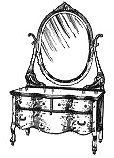

Click here for more bedrooms from the 1910s!
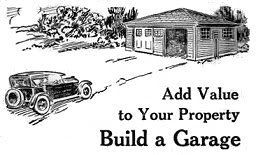

|
_________________________________________________
|
|
|
RetroLisa
| ___________________________________________________________________ | __ | _____________________________ | _______ | In The Kitchen
In the 1910s, middle class kitchens began to resemble the kitchens of today. They contained a sink, stove, and icebox....the three items we associate with the modern kitchen. To create a more efficient work space, housekeeping books recommended the triangle floor plan, which placed each appliance at the point of a triangle. This marked the birth of modern kitchen design.
electric toasters
The first electric toaster went on the market in 1909. Before this, bread was toasted in a metal device placed over an opening in the cookstove. In an electric toaster, doors on each side held the bread against a central heating element. Now it was possible to make toast without firing up the entire stove. There was one drawback, however....bread still had to be watched and flipped by hand.
other electric appliances
The modern kitchen in the 1910s contained the latest electric appliances....waffle irons (1918), refrigerators (1911), ranges (1906), and dishwashers (1914).
| |
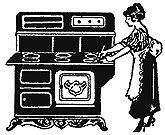
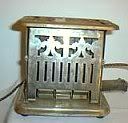
Electric toaster

Click here to see more kitchens from the 1910s!
|
_________________________________________________
|
|
|
RetroLisa
| ________________________________________________________________ | __ | _______________________________ | ________ | In The Bathroom
In the 1910s, most middle and upper class homes had running water, and most towns of 5,000 or more inhabitants had city water and sanitary sewers. Many smaller communities chose this decade to upgrade their public utilities by adding water and sewer systems.
older homes
When it was time to add modern plumbing to an older home, unused bedrooms were converted into bathrooms whenever possible.
Unfortunately, it wasn't always possible to install the fixtures in the same room. Many homeowners were forced to install toilets and tubs wherever they could find room for them. Toilets were located in closets or basements, and bathtubs were installed in the kitchen or utility room. If space in the toilet room was lacking, one particular 1919 book suggested placing the tub in the kitchen, where it could be covered with a board and used as a table when not used for bathing.
new homes
In the 1910s, most new homes were built with complete, fully-connected bathrooms.
It was easy to include a modern bathroom in your plans. The 1910 Sears catalog sold a complete bathroom set for $49.95, consisting of a sink, claw-foot bathtub, and water closet (toilet). The Standard Sanitary Manufacturing Company sold bathroom sets ranging in price from $78 to $600.
bathtubs
Traditional tubs were designed with claw feet or pedestal bases. In the 1890s, the first built-in tubs were simply claw-foot tubs surrounded by panels of wood or tile. The built-in look became common after 1911, when Kohler introduced the first rectangular enameled bathtubs with fully-enclosed bases.
By the 1910s, enameled cast-iron tubs were replacing old-fashioned copper, zinc, and solid porcelain tubs.
toilets
The modern siphon flush toilet was developed in the 1870s and 1880s, and was first sold in its modern form in 1885. Naturally, toilets were only found in upper class homes at this point.
By 1920, the number of American homes with a flush toilet reached 20 percent. This figure represents all homes, regardless of class or location. For middle class homes, the total was probably closer to 50 percent.
Prior to the 1910s, most toilets featured a tank mounted near the ceiling and a pull chain for flushing. In the 1910s, models with low tanks became common.
The modern bathroom had arrived.
| |
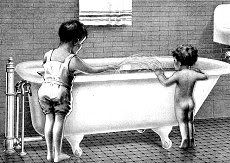
Enameled claw-foot tub, 1915
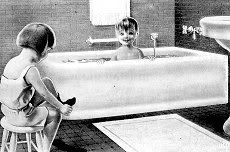
Built-in enameled tub, 1915
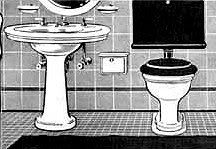
Pedestal sink and modern toilet, 1910

Click here to see more bathrooms from the 1910s!
|
_________________________________________________
|
|
|
RetroLisa
| ___________________________________________________________________ | __ | _____________________________ | _______ | Appliances & Housework
In the 1910s, modern technology was changing the nature of housework. New labor-saving devices were removing much of the drudgery associated with household chores. Walls and windows required fewer cleanings, because electric lights and gas furnaces didn't leave any soot behind. Houses were becoming easier to clean, but unfortunately this didn't necessarily reduce the amount of cleaning a housewife did. Standards of cleanliness continued to rise along with the use of modern appliances.
"mechanical servants"
The new electric appliances were known as mechanical servants. They were used in upper and middle class homes where electricity was present. For affluent households, the decline in domestic help meant that more wives were doing their own housework. Because of this, new appliances were adopting a more attractive and less industrial appearance.
vacuum cleaners
The first electric vacuum cleaners for the home were sold in 1908.
Owners of large houses could install a central vacuum system. Each room had an opening in the baseboard, which was connected by pipes to a motor in the basement. The hose apparatus was moved from room to room and was connected to the opening.

electric irons
The first successful electric iron was introduced in 1907. The time-consuming ritual of heating irons on the stove, switching handles, and checking temperatures was over!
gas & kerosene irons
Some irons were powered by gasoline or kerosene, which was stored inside the handle or in a small container behind the handle.
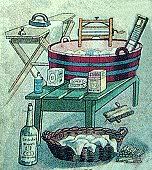
Laundry was the housewife's most dreaded chore.
Because of this, laundry day was known as Blue Monday.
manual washing machines
Manually-operated washing machines were filled by hand. Water was hauled from the pump or sink, heated on the stove, and poured into the tub. These machines used a variety of methods to force water through clothes. Turning a crank moved a wooden dolly back and forth, moved plungers up and down, tumbled clothes in a round chamber, or rubbed clothing between rough wooden surfaces. A wringer mounted on top squeezed excess moisture out of clothes.
electric washing machines
The first electric washing machines went on the market in 1907. The job of rotating the chamber or moving the dolly was taken over by an electric motor placed beneath the tub. In some models, the motor also powered the wringer. In all other ways, these new machines were just like their manual counterparts. Water was still hauled from elsewhere and heated on the stove, and clothes were still rinsed in separate tubs or laundry sinks.
housewife's weekly schedule
Monday - laundry
Tuesday - ironing, mending, sewing
Wednesday - baking
Thursday - grocery shopping
Friday - cleaning, dusting, sweeping
Saturday - cleaning, baking for Sunday dinner
Sunday - church, large family dinner, go visiting
| |
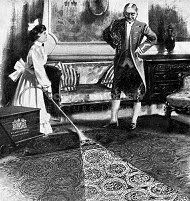
Vacuum cleaner, 1911
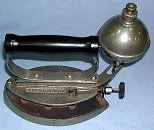
Kerosene iron
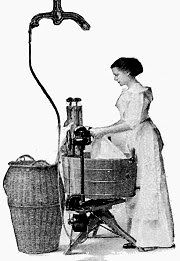
Electric washing machine, 1913
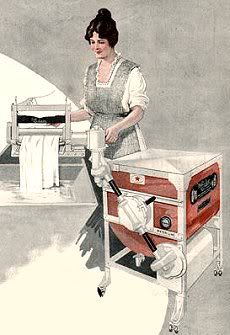
Electric washing machine with wringer that swings over laundry sink, 1919

Peoria hand-cranked washer with wringer that swings back and forth from washer to basket, 1914
|
_________________________________________________
|
|
|
RetroLisa
| ___________________________________________________________________ | __ | _____________________________ | _______ | Electricity & Lighting
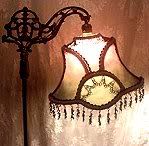
electricity
Although electricity was still expensive, it was gradually coming down in price. During the 1910s, the number of homes wired for electricity grew steadily: 16 percent in 1912, 20 percent in 1917, and 35 percent in 1920.
Most homes had only enough wiring to power their electric lights. When electricity was needed for a small appliance, there were two ways to tap into this power source. The first method used a stationary light fixture as an electrical outlet. The bulb was removed and the appliance was plugged into the empty socket with a screw plug or a two-pronged plug with a screw adaptor.
The second method used a convenience wall outlet, which was available in a variety of styles to accept either a screw plug or a two-pronged plug. Wall outlets had been around since at least 1897, but they didn't become common until the late 1910s. At this point, one or two convenience outlets were considered enough for the average home.
During this decade, many homes had a combination of gas fixtures and electric lights. Electricity was still very unreliable and was prone to outages of up to a month at a time. Alternative lighting came in handy.
In the 1910s, larger electric appliances (vacuum cleaners, washing machines, refrigerators) required higher power levels. Some homeowners began to install additional heavy-duty wiring to support them.
day current & night current
Prior to the 1900s, power plants operated in the evening only. This was because electric lights were generally the only things they powered. Usually this night current was turned on between 8 p.m. and midnight.
When the first practical electric appliances were introduced in the late 1900s, customers needed daytime current to operate them. Irons were very popular, and most of the housewives who requested day current wanted it for ironing. Since Tuesday was "ironing day" in most households, this was the one day a week when power was turned on during daylight hours.
By the 1910s, most towns had adopted day current for at least one day a week, and many towns had expanded to 24-hour service.
gas lighting
Gas was first used for street lighting in 1807. It was adopted for home use in the 1840s and was relatively common in urban homes by the 1870s.
The introduction of the incandescent lamp (light bulb) in 1879 spelled the beginning of the end for gaslight. Even so, gas continued to be a popular choice for home lighting until the 1920s. Electric service may have been available in your area, but conversion to electricity was still expensive and was often not undertaken until a house was sold to new owners.
The introduction of the atmospheric burner (1886), gas mantle (1883), and inverted burner (1905) kept the gas lighting industry in business a bit longer after the light bulb came along.
Older gas lamps used an open flame to provide light. Atmospheric and inverted burners replaced the open flame with a small blue flame, which depended on a gas mantle to provide light. A gas mantle is a small cotton mesh cap soaked in minerals. When placed inside the gas lamp, the cotton burns away, leaving a chemical mesh that glows brightly when heated by a gas flame.
Inverted burners pointed downwards, which made them more versatile and efficient than traditional upright flames.
Some homes were fitted with electric wiring before electricity was available in the neighborhood. Other homes were lit by both electricity and gas at the same time. During this transitional time you could install transitional fixtures that used both systems. The electric bulbs pointed down and the gas flame pointed up.
| |

Sewing machine plugged into light socket
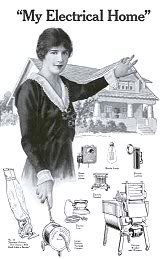
My Electrical Home, 1916
This Western Electric ad shows the latest electric appliances in 1916....vacuum cleaner, iron, toaster, telephone, light bulb, flashlight, and washing machine.

Gas mantle

Transitional fixture using both gas and electricity
|
_________________________________________________
|
|
|
